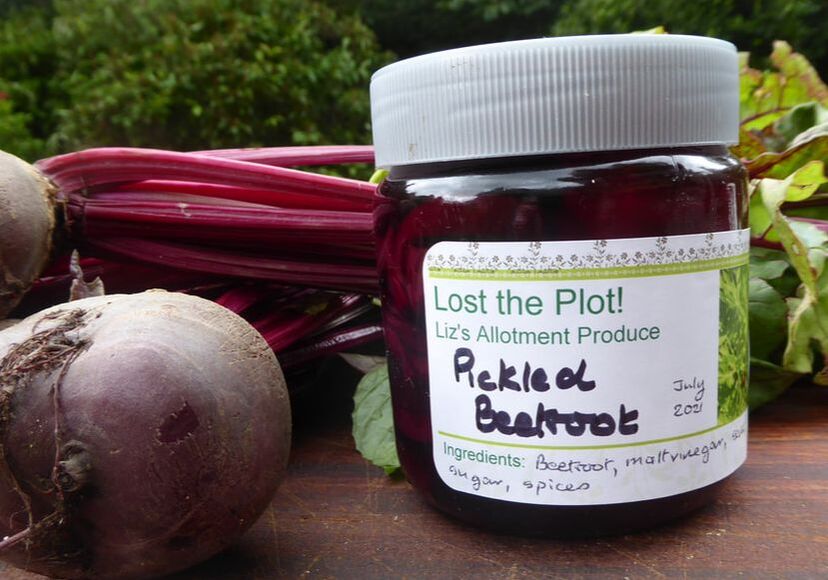|
Home Pickled Beetroot
Now we’re coming into preserving season, making jams and savoury jars of loveliness to remind us of Summer sunshine in the depths of Winter and to perk up our tastebuds in the cold weather. Pickled beetroot is the absolute easiest thing to make, requiring no special equipment and tastes so much better than the shop bought jars. You can adjust your seasoning to your own taste and feel so proud when you bring the beautiful jar of deep purple slices out to enhance a meal of cold meat or add to a corned beef or cheddar sandwich. Is that only a Northern tradition? Delicious anyway, if messy. If you don’t grow your own beetroot – which is lovely tolerant vegetable and quite easy to grow if you don’t sow it too early as I always do – then get a pretty bunch of fresh beetroot from your green grocer. If you buy it with the tops on you can see how fresh it is – the leaves are also attractive. Wait till you have the oven on for a roast or something; beetroot doesn’t mind waiting a couple of days in the vegetable drawer. I like to roast my beetroot, partly because I’m lazy and partly because I like the taste better. The taste of beetroot is often described as “earthy” which doesn’t properly catch the sweet autumn smoky depth of this wonder vegetable. It’s supposed to be one of the true “superfoods” having a proven ability to reduce blood pressure. Maybe so, but I’d eat it because it tastes so good and looks so beautiful. The health benefits are a pleasant bonus. I make a batch of pickling vinegar up every now and then, cool it and put it in a clean bottle. It keeps in a cool place for months and means you can just heat it up and pour it over sliced beetroot whenever you have some around. Makes 2 jars Timings: 2 hours roasting and overnight cooling down for cooking the beetroot, 30 minutes for preparing the vinegar and pickling the beetroot but this will give you more vinegar than you need so it will take you less time when you do another batch.
Roast the beets: wrap the beetroot in foil, either individually if they are fist sized or in twos or threes if they are smaller. Seal the parcels well and put on a tray in the oven when you have the oven on for a roast or casserole. Let them cook along with the other dish for about 2 hours, depending on the size and then leave them in the oven when your other dish is done, to cool down with the oven. I find this gives me perfectly cooked tender beetroot. In the morning, take them out of the oven (doesn’t matter if you don’t remember till later) and keep them in the fridge until you use them. They will keep for a couple of days before you have to pickle them. Clean your jars: I like to use peanut butter jars or other jars with pure plastic lids so that the vinegar doesn’t get a chance to corrode the inside but jam jars will do. Fill the jars full of boiling water, then empty and dry. Make the pickling vinegar: put the vinegar into a small pan with all the ingredients, bring to a simmer. Taste and adjust the seasoning – I like it quite sweet so I sometimes add another teaspoon or two of sugar. You could even add honey if you like the additional flavour. Let the pan simmer for a couple of minutes, then let it cool nearly to room temperature to infuse the spices into the vinegar. Strain the vinegar and discard the spices. This is your pickling vinegar now. Bring it back to simmering when you’ve sliced your beetroots. Unwrap your beetroots and just rub the skin off. It will come off easily. Wear gloves if you don’t want stained hands but it’s quite fun to get red fingers. Halve the beetroots if they’re large and slice into very thin slices using a sharp knife. As you slice, feel the texture, it should be a buttery softness. If you get any fibrous bits (which can happen with home grown beetroot if you leave it too long in the ground and it goes woody), cut round them if you can. Place the sliced beetroot into the jars, working like a puzzle master to fit the most slices into the jar that you possibly can. Put them in horizontal layers with some stuffed vertically down the gaps. Fill each jar to within about 1cm of the top. Pour the hot vinegar directly into the jar. Using a knife or skewer, poke down into the jar to release any air pockets – you can see them from the outside. This will help them keep better and let you get a bit more vinegar in. Top up with more vinegar to cover all the beetroot, seal the jars and keep in a cool darkish place. They don’t have to go in the fridge until you open the jar. Keep any un-used pickling vinegar in a clean bottle or jar until you get the next batch of beetroot to process. You'll be surprised how much you get through in a year, once the family get the taste for the home made stuff.
0 Comments
Leave a Reply. |
Some Changes - April 2022
Thanks to my friends and followers for your patience, and for your encouragement to start blogging again. Archives
April 2022
Categories
All
|

 RSS Feed
RSS Feed
